Many poker articles and books give players lots of general advice. Here are 4 very specific moves and situations every poker player should have in their “arsenal”.

This is a move to make when you are Under the Gun or UTG +1 (i.e., first to act). Start off just by limping/calling the big blind. Often, the pot will be raised by one of the other players (if not, you get to see a flop for cheap). If no one 3-bets the original raiser, here is where you make your move. Make a BIG re-raise back at the original raiser – you will be taken very seriously and most hands will fold.
The reasoning behind this move is simple: TONS of players will make this type of play with monster hands in early position. Therefore, your bet tells a very believable story and has a high chance of success!
*When NOT to make this move:
Many times you might find yourself betting out with a drawing hand on the turn against a single opponent. If your opponent folds, great! But if he/she calls, immediately you start wondering if you should bluff if your draw doesn’t come. In the meantime, the river is dealt and your opponent is watching you debate your move. In other words, you may be giving away valuable info.
To prevent this from happening, bet out before the river comes (in the dark)! This will throw your opponent off guard and prevent you from accidentally giving off any tells; as you’ll have made your move already.
*When NOT to make this move:
 3. The Counter Fitter Bluff
3. The Counter Fitter BluffYou’ve made a decision in advance to “go for it” and bluff to win this pot; no matter what. First of all, good luck!
To better “sell” your bluff, ask the dealer how much is in the pot and take a minute to “calculate” your bet (if you’re in a home game, just stack the chips in the pot to count it up…). This will get your opponent thinking that you’re trying to maximize your value, and thus be far more likely to put you on a strong hand.
*When NOT to make this move:
“Aggression aggression aggression” may be the overall key to poker. However, if you find yourself with a nut drawing hand in early position on the turn, as tempting as it might be to fire at will you might want to try checking and letting someone else do the betting for you (you may even get some extra callers before it’s your turn to call the bet). The payoff here is in having multiple players still active in the hand if your nut draw hits. You’re more likely that at least one player (possibly more) will call off their stack to you on the river.
*When NOT to make this move:
*David Shatsky is a longtime member of the Cardplayer Lifestyle family. We’d like to thank him for this guest post.
Do you have positive or negative experiences making poker moves like these? Are there any other awesome poker moves you’d recommend people make to profit at the tables? Share your thoughts with us below.
Ask anyone who enjoys playing casino games whether poker or roulette is a better game and they most likely will give you a quick and definitive answer. However, personal preferences alone don’t make one game superior to another, so I decided to look into the issue a bit further, defining specific categories and staging a 3-round roulette vs. poker showdown to determine which is truly superior.
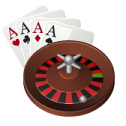
Let’s examine a scenario in which you are attempting to double your winnings.
The odds of roulette are pretty straightforward based on the type of roulette game you are playing. So, for example, in European roulette the house advantage is 2.7% and you have a 48.65% chance of doubling your money per bet.
Calculating the exact odds of doubling your money in poker is a bit more complicated because every hand is different. For the sake of this example, we can assume that since we are trying to double our money, we will be going all-in before the flop. The odds of you blindly winning an all-in (and doubling up) against a single opponent in Texas Hold’em poker with any 2 random cards is 20%–25%, obviously far lower than the roulette odds.
Round 1 winner – Roulette
In our first example, we were trying to double our money as quickly as possible, so we went all-in before seeing the flop. In this example, however, let’s assume we are talking about a skilled player, with a far better knowledge of the game of poker. The odds of doubling your money at roulette remain static – so still 47.3%. In poker, however, skilled players usually tend to win over the long run and are thus far more likely to eventually double their money. As a matter of fact, the odds of them doing this shoot up to well over 60%.
Round 2 winner – Poker
Playing roulette involves choosing a winning number, color, or sequence on the roulette board and having the wheel spin and land on the corresponding number/color you have chosen. It is incredibly easy to begin playing roulette.
In order to make the most money from your bets, however, you need to increase your skill by learning about all the different playing options available to you, such as reverse martingale betting.
Playing poker involves a complex set of rules in order to participate in the game on the most basic level. Becoming a skilled poker player often takes many years of hard work. Many people enjoy increasing their skill in the game and claim that it’s one of poker’s advantages over other casino games. However, in terms of ease of overall gameplay, roulette is definitely the winner, hands-down.
Round 3 winner – Roulette
After three rounds of showdown we’ve got poker with 1 win and roulette with 2. Undoubtedly, some people will disagree with our methodology and the specific barometers that we used to measure game superiority. Feel free to express your criticism or support below in the comment section.
The benefits of webcams to online poker players are many: they let you watch your opponents, prevent cheating, and stop multi-accounting. While you’re sitting comfy and cozy at home alone, you get all the fun of being surrounded by friendly people, have facial expressions and tells to go by, and have the opportunity to win big money. With webcams, poker becomes a form of entertainment that’s not just all about the money.
The idea of introducing webcam into online poker has been hotly debated in the poker community for a while. People against the idea have cited the tendencies of online poker players preferring to play half dressed, without smiles on their faces (like robots), or while eating; all of which paint webcam poker in a much more negative light. They also say that it’s tantamount to an invasion of privacy, which is something online poker players prefer (otherwise they’d be playing in a live setting, right?).
So then, would you consider webcam online poker a privacy disaster or rather a new virtual opportunity to socialize?
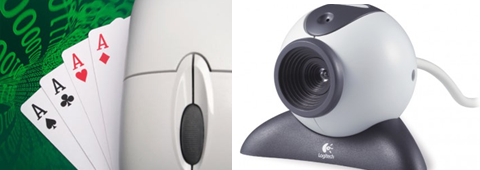
Many online poker rooms with webcam poker options push their benefits, trying to carve out a niche as the quintessence of being social online while playing poker. On top of that, they’re happy to remind players that webcams will allay all their fears that they might be playing against bots or multi-accounters.
Some of the main advantages of playing webcam poker include:
Still, some players are quite wary of webcam poker, as they consider anonymity the most important part of playing online. Here are some reasons certain players will almost never be convinced to play webcam poker:
If you’re quite the slob, party hard, and don’t care to look civilized, webcam poker certainly isn’t for you. Moreover, you’d honestly be doing everyone else a favor by not showing your face at the online poker table.
Almost all online poker rooms that offer webcam poker also have strict codes that all players who opt in must follow. Here are some rules common to most such rooms:
1) Webcam on Face
While playing, your face must be visible at all times. If your webcam is pointed at something else, and that means ANYTHING else, you’ll receive a warning from a moderator.
2) No Nudity
An online poker room is simply the wrong place for this sort of thing. Regardless of how good you look, flashing any extra skin is going to get you banned – no questions asked.
3) Hats
Just like at live poker tables, it’s okay to wear hats while playing webcam poker, so long as opponents can see your face clearly. If not, then lose the hat, or you’ll lose your account.
4) Sunglasses
You are allowed to “hide behind” sunglasses at webcam online poker tables. If you feel as though this will prevent your opponents from getting a read on you, then more power to you.
Failure to adhere to those policies could lead to your online poker account being suspended or even permanently banned from the site you play at. So the bottom line is that if you want to try webcam poker online, you better be prepared to follow the rules of play. The fact of the matter is that the online poker rooms have these rules in place in order to prevent rudeness, abuse, and ensure player protection from scams.
Webcams are an exciting new development in the realm of online poker. If you decide to give them a try, just stick to the rules, wear a smile (and decent clothing) and you’ll be just fine. As for whether you should wear your personality on your face and focus on being more social, or try to keep a stone cold poker face while grinding out a profit, we’ll leave that question up to you.
With webcam poker, as much as the action is taking place online, everything truly becomes more real – including the prize money. Check out the list of the best online poker rooms out there and give it a go.
Do you believe that 50% of online poker traffic will come from mobile apps? Well, this could happen as soon as 2014.
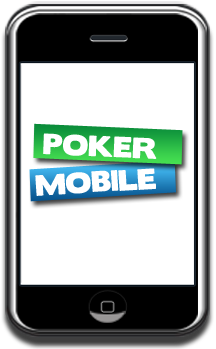
The trend is shifting to mobile, especially with more people buying iPads, iPhones, and Android devices instead of bulky PCs and laptops. That said, most high-ranking professional online poker players will still rely on large screens and downloadable software. These guys aren’t the ones who are likely to be playing with a cup of coffee during lunchtime. They play hard, smart, and serious. Thus, mobile poker apps are likely to bring in the large pool of recreational online poker players – those who play to have fun and possibly win some cash along the way.
Most people use their mobile devices for entertainment only. They check email, play games, and update their Facebook pages; and with increasing regularity they prefer to do this on larger tablets than on mobile phones. Demographically speaking, most of these people are women and older people; clearly not the stereotypical online poker players.
In any event, online poker rooms continue to look for new technologies to make the mobile poker experience better than ever. For example, you can now enjoy multi-table poker on your mobile device; playing at up to 4 tables simultaneously. Superb graphics, fast software, and plenty of bonuses are guaranteed. The more mobile technology improves, the brighter the potential future of mobile poker. More and more people are starting to play mobile poker than other entertainment games. Many online poker rooms also hold special tournaments exclusively for mobile users. Cashing out and making deposits into your account on the go are now a reality. However, such widespread accessibility can also have some disadvantages.
Mobile poker could become incredibly addictive. As it is, most people are already glued to their smartphones. Throw in the gambling elements and adrenaline-fueled excitement of online poker and you’ve got yourself a major potential addiction. With people able to play from anywhere at any time, including at lunch, on breaks at work, or during their commutes even recreational fans of the game may soon find themselves completely consumed with online poker on their mobile devices.
Those with addictive tendencies and who seriously love the game of poker will find ways to play even if they’ve got no Internet connection nearby. To counter these negatives, many online poker rooms have implemented strict policies to try and curb accessibility to those who don’t know how to gamble responsibly. For instance, some have implemented pre-set loss limits.
The more new mobile poker apps that are being developed, the more sophisticated the graphics and features are becoming as well. In fact, plenty of iPhone mobile poker sites can boast decent software and fast deposit and withdrawal transactions. The competitiveness on the market promises to provide us with advanced, user-friendly, and easy-to-navigate software. With every new type of smartphone that gets released, the online poker operators will respond with excellent software to run on it.
Other value-added content these operators have begun to provide include the latest interviews with top players as well as tips and strategies that can help make recreational players a lot better. And of course, these are being made available on both the iOS and Android operating systems.
Thus, if you are still in doubt about the mobile future of poker, why not go ahead and keep an eye on what happens in this exciting field over the next two years. If what’s happened thus far is anything to go by, future developments should be quite impressive to say the least.
The majority of poker players today are long term losing players. A player may think he is most definitely making the only right move, while a more experienced player is laughing at him from the other side of the felt. There are many factors to consider and much experience to acquire before you can be certain that you’re definitely making the proper plays in poker.
If you want to win, you cannot be a passive player that rarely bets or raises and just limps through the game and only relies on massive rakeback to survive. Betting, raising, and going all in are absolutely crucial to getting ahead. Just calling and/or betting too much or too little can be quite disadvantageous to your game. If you bet too much, you may find other players rarely call you, leaving you to win only small pots or losing a large portion of your stack. If you bet too little, you may actually be inviting your opponents to dominate you. When deciding upon how much to bet, you need to consider how many blinds you have as well as the size of the pot. It’s not a bad idea to start off your betting with three times the amount of the big blind.
Position combined with the number of players in the game can also help determine just how valuable your hand is. It can be the deciding factor on whether to go all-in or just fold. (For example, say there is a full table; you have 10bb and presently are on the button. The five players to act before you have all folded and the small blind and big blind still have to act after you. You’re holding an A8 offsuit. Because of your position, you can go all in here. But, if you were in the “under the gun” position (the first to act in the game) at a full table, it would probably be in your best interests to fold that exact same hand.)

With endless combinations of hands and plays, you will often encounter quite a few plays which you will not be 100% sure how to react to. Hands that are difficult to play in Texas Hold’em SNGs are A10, AJ, and AQ, as they are often way overvalued. You may even see some people in the beginning of a tournament, with well near a hundred blinds in their stack ignorantly going all in with this hand. These people do not understand that these are not premium hands and will often bet their entire stack on them. The value of these hands all depends on how deep you are in the game, your position in the game, and the amount of blinds that you have in your stack.
What about AK you ask? With this hand, it is usually a good idea to bet, and then, depending on the flop, determine whether or not to bet, raise, call or fold. Small pocket pairs? Sometimes it pays to set mine (hope to flop three-of-a-kind), but if it’s too expensive to do this, they should be immediately folded.
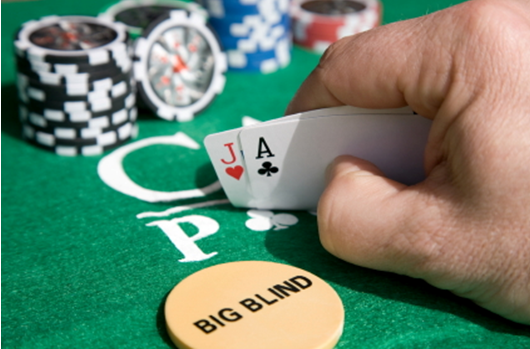
One of the most difficult, yet beneficial, aspects of tournament poker play to master is playing “on the bubble.” The bubble is the situation in which the number of players left is equal to the number of spots that make the money + 1. This situation greatly affects how players play (as nobody wishes to be the bubble boy and make no money for all their efforts). Your range and rules of play may change a lot at this point. You may make plays that you would not dare to at earlier levels of the game. You should view the bubble is your chance to get ahead and acquire loads of chips. Players in the bubble tend to play much more passively or much more aggressively than usual. Seeing at least one player go all-in every hand is quite common. If you remain inactive at this later stage of the tournament, the blinds are likely to begin eating up your chip stack. While many stages of the tournament can pretty much be played on “auto-pilot,” the bubble is a situation in which you must really increase your focus.
With so many different influences and contributing factors it is hard to be certain if you are always making the best possible plays. The key is stepping back once in a while and examining the whole situation at the table: position, your hand, the blind levels and number of players left (in a tournament). If you follow the advice from this article, you’ll be sure to feel as though your poker game is at least a little stronger.
Do you remember your last poker session where everything went wrong? That night where your big pairs got broken over and over and your opponents hit every draw… The hours of frustration as your chip stack got lower and lower and your tilt got stronger and stronger… Every poker player at one time or another has experienced a session where nothing seems to go right. Sometimes these sessions can have drastic effects on certain players and may even result in a winning player quitting the game altogether.
Yesterday I had such a session but, other than a few curses under my breath (even the most experienced players get a bit tilted) I wasn’t fazed. I hope that after reading this post you, too, will look at luck in poker in a new light.
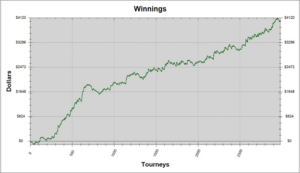
The reason I didn’t let this horrendous session affect me is because I believe in two fundamental aspects in regard to my poker play. The first is that I am a winning player in the games I play and have a sufficient sample size to prove this statistically (see graph at the right). The second is that every now and then my results on the virtual felt will deviate from the expected in a negative direction. Sometimes this deviation can be extreme. Once a poker player can accept this reality, dealing with downward swings and tilt becomes much easier.
I play primarily online at PokerStars, where I play hundreds of MTSNGs (Multi-table sit & goes) a month. In order to help me during my sets I use a tracking software called Holdem Manager. The software tracks every hand and provides me with detailed reports on my play from a purely statistical standpoint. Having access to this information allows the serious player to identify if he or she is experiencing a run-bad induced downswing or simply playing purely.
The information below is an in depth statistical analysis of my session yesterday. You can clearly see the multiple deviations from the statistical norm and how this compounded affect resulted in me losing money in the set.

The numbers above clearly show that when I was all-in pre-flop, a common situation in shallow-stacked tournament poker, I ran almost 200% below expectation. The flopped set % was also very low which made it tougher to double up early on, thus resulting in fewer deep runs. If you now compare the actual results shown above and the graph below, you will see how little impact this set had on my bottom line. If I let the horrendous run bad I experienced in this set affect my thoughts or emotions towards poker, it could result in me putting in less volume, making negative adjustments to my winning strategy or even quitting the game altogether.
It is important to remember not to get too fixated on the statistics, especially if your sample size is small, as this in itself can cripple a player as they sit all day looking at numbers and not putting in volume. I recommend spending more time on the stats if you are a newcomer to the game who is trying to improve so that they can identify their strengths, weaknesses and if they are just running bad or actual profitable poker players.
I hope this post shared some new insights into how to approach the game we all love by breaking it down into a game governed by mathematical and statistical laws and accepting the fact that any one session is irrelevant in the grand scheme of things in comparison to the end result. If you have any questions or comments then please leave them in the comments section below or contact me directly via twitter.
This is a guest post by Justin Butlion, an entrepreneur, poker player and web developer. He blogs at The Great Grind and can be found playing on PokerStars under the nickname hawkeye77787.
For almost an entire year now, ever since Black Friday, the entire gaming industry has been waiting with bated breath to see if online poker will ever be officially legalised in the U.S. Indeed, it’s difficult to even comprehend how many articles have been written about the issue, how many hours have been spent discussing legal technicalities and how much effort has been spent by lobbyists and state and federal legislators trying to get some sort of bill to pass that would regulate and licence online poker. Strange how in the most advanced country in the world, this would be such a contentious issue, especially when it seems like online poker is legal in so many other Western countries! If legislation is eventually passed in favour of online poker, however, one then begins to ponder whether the next logical step would be to allow all forms of gaming online, such as casino games.

All online gaming operators will admit that the “real money” for them in the industry is not made via offering an online poker product, but rather via online casino games. Many of these companies have seen tremendous success via marketing their online casino games to eager gamblers in the UK, continental Europe, and other Commonwealth jurisdictions like Australia and Canada. Though surely they’d be thrilled to have the U.S. online gaming market open to them in any fashion, no matter how small, when the door finally opens for poker you have to wonder if the operators will then begin lobbying to be allowed to offer casino games online to U.S. players.
After all, as almost anyone would tell you, Americans who play poker in land-based casinos often visit slot machines and table games such as blackjack, roulette, and baccarat. It stands to reason then that these same people, if given the chance to begin playing poker online, would also give online casino games a shot too – and believe you me, gaming operators would be standing by ready to offer table games and online slots to Americans!
In the meantime, we continue to wait for the green light from Uncle Sam…
One of the most widely recognised and enjoyed card games, poker is played online and in casinos across the world. The popularity of websites which offer these games is so great that even music star Robbie Williams, a self-confessed poker fan, is preparing to launch his own site.
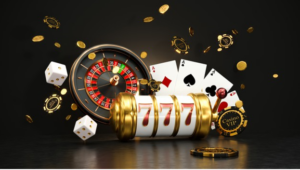
Perhaps the reason poker has won the hearts of the nation so easily is because of the variety which it offers. Not only are there numerous forms of the game but there are also many different skills that are required for players to be successful.
Ultimately, poker is the perfect game because it combines chance with skill and confidence. Those capable of card counting can determine the probability of cards being laid and act accordingly, giving the game a certain element of risk and adventure.
On top of this, the concept of ‘bluffing’ has transformed the game into something which is internationally recognised and enjoyed. This deceptive element adds another layer of fun to the proceedings and is so well know that the expression ‘poker face’ is now used freely across the world.
For those interested in playing the game online, the preferred format is usually Texas Hold’em. This version includes a larger number of betting stages and therefore makes the potential winnings high. There are also more opportunities for individuals to adapt their hand or exit the game, making it fast-paced and exhilarating to play.
Whilst poker offers the perfect challenge for even the most experienced player it is, of course, not the only card game available. Nowadays, a whole range of games can be played from the comfort of your own home and that allow you to have the full casino experience without going outside. This means that the average card player can hone their skills at their convenience and even try their luck at the wide range of other games available.
For those interested in trying a new challenge, here are three great alternative card games to poker:
Sometimes known as ‘21’ this is a great card game which has featured in numerous movies throughout the years. Off the screen, the game has been a regular addition to casinos and has been transported into the digital realm for the convenience of modern players. With simple rules and a certain level of skill needed, this is a fast-paced and exciting game perfect for those looking to try something a little different.
An ideal game for any player, solitaire is a game which has been played in homes and casinos for numerous years. Nowadays, popular versions of these games are even installed on Windows PCs and those looking to earn money from their fun could take their chances and play online.
Another great game, Hearts requires a set amount of players and follows a specific pattern and set of rules during play. This is the perfect game of strategy and skill, making it the perfect way for poker fanatics to hone their skills before returning to the card table.
Ed. note: In this guest poker blog post, Victor Luebker discusses strategy for (relatively) low-stakes poker players to potentially make big scores in high-buy-in live events via qualifier opportunities.
Folks, given all the mess we see at Full Tilt Poker with pros owing up to millions of dollars each, I want to share how I treat poker as a blue collar enterprise. I feel that the days of great poker for players like you and me have never been better if you do things right. First a quick update.
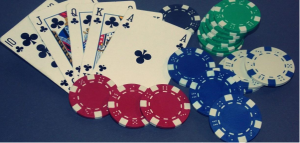
I played a $200k WPT regional event at the Hard Rock in Ft. Lauderdale, FL last week and also won a seat to the HPT main event this weekend that I’ll share more on below. The Seminole Hard Rock is a blast as far as the property goes, with great shops, casino, food, and bars and the weekends have an awesome nightlife – so I recommend you put this place on your visit list. The poker room is a bit crowded on weekends due to all the cash action. I had a great dinner at one of the plaza restaurants and just missed cashing in this event, but am still on a roll since graduating WPT Boot Camp a month ago with five top-4 cashes in 11 events! That said, let’s talk blue collar poker.
First thing: I think anyone looking to move up in levels or cash more in poker tournaments needs to get educated! I can’t stress how much we don’t know about our game and the holes we have at the table that other more experienced players pick up on. The only way to plug those leaks is reading and mentoring and training. I completed the WPT Boot Camp a month ago and had some great sessions with top pros like Nick Binger and Kathy Liebert. Blue collar players tend to ignore the investment in themselves they have to make in order to cash more regularly. I recommend that you instead look at this as an investment in yourself and, like any “TRUE” blue collar player, fund your training via cashes over time. I suggest you carve out 50% of your wins until you get the funds and then attend a clinic. Now let me put this in perspective. My camp after discount sold for $1595. Since then with my five cashes I’m up net $4900 in a month with a main event opportunity to still be played this weekend. All top level players in poker, baseball, football or other active endeavors have training and coaches and so should you!
Next, I play many of the qualifier events as I travel and this is a great way for blue collar poker players to get into large events on the three major tours (WPT, WSOP and HPT) for pennies on the dollar. In the event this weekend I won a seat in a 20% qualifier and will now play in an event with an estimated $400k prize pool and a $1700 cost for just $360 (my qualifier cost). Many of us started in local card rooms or playing the $65 tournaments with 15 or 20 minute levels and that’s the training grounds of tourney poker. However, playing the larger $2k to $5k events is not as far out of reach as you may think. As blue collar poker players you can invest some bankroll in these qualifier events for as little as $100 in live brick and mortar rooms.
Here is what I do: First I research the event I want to play like a WPT regional. I look up the website for the host location and print the qualifier schedule out. Then, I select a couple events I plan to play in with the idea being to invest up to 30% for qualifiers looking to get a seat for the large prize pool. This budget will buy me between 3-5 chances to qualify, so if I cash just 20% of the time I’m in!
That said, you can see these larger money events are not that far out of your reach. But remember, education comes first. Get a mentor, poker books, and attend a live camp or take an online training course so you’re ready for the level of play that comes with $2k+ events. Now go be a “Poker Shark” like me! Next post will be about my HPT weekend and next trip in two weeks to Vegas for the Wynn Classic.
Ed. Note: This poker room review was written up by one of Cardplayer Lifestyle’s loyal readers, Hank_AK. We would also like to thank him for the courtesy photo.
Casino Copenhagen is situated connected to the Radisson Blu Scandinavia business hotel at 70 Amager Blvd. One can access the casino either directly from the outside or from within the hotel. The casino charges a 90DKK ($15) entrance fee and a picture id is required. They have 4 active roulette tables, 3 active blackjack tables and one active Ultimate Texas Hold’em table (you play against the house). When there are significantly more visitors to the casino they can double that amount of table games, but when I was there they kept to the tables listed above.
Every night they have a different style Texas Hold’em tournament. For example, on Mondays, they play a 400DKK ($70) buy-in bounty tournament (each bounty worth 100DKK) with a maximum of 30 players on 3 tables and minimum of 10 players on one table. On Tuesdays, they play a rebuy tournament with a buy-in of 250DKK ($45) and rebuys until the first break (maximum 20 players and minimum 10 players). The poker tournaments all start at 8 pm and there’s a 15-minute break every 75-80 minutes. Cash tables open at 8:15 pm and the lower stakes table featured a minimum buy-in of 1000DKK ($175) with a maximum buy-in of 10,000DKK ($1,750). Most poker tournaments at Casino Copenhagen end by 1:00 am.
If you’re sensitive to smoke, be advised that the casino has open-sided smoking booths inside the casino; in general, smoke stays inside the booth but if you wander past the booth you’ll probably get a whiff. It being Denmark, the language spoken at the tables is Danish, but chips and cards talk best and if one doesn’t understand something, the dealer and players will respond in English, which is widely spoken in the country. Some dealers are better than others and a couple of them made small mistakes at my table that would’ve influenced the action had I not spoken up, so be sure to pay close attention to everything going on at your table.
All in all, since this is pretty much the only game in town, if you’re a poker player and find yourself in Copenhagen, it’s well worth a visit for a fun night of Texas Hold’em.
If you would like to submit a poker room review or other poker blog content for publication on Cardplayer Lifestyle, please contact us.
Welcome to the opening poker blog post from a regular guy playing poker at WPT, WSOP, and HPT (Heartland Poker Tour) events around the country. My blog posts will be about players like us – not high profile pros telling stories about private jets. First, a little more about myself and what my blog posts will be about… I jokingly refer to myself as the greatest player in the world that no one knows about.

I’m Victor Luebker and I decided to take 2012 and live my dream of playing professional poker on tour. As I travel around over the next year making stops at all the major tour events I’m going to share my successes and failures with Cardplayer Lifestyle readers, as well as what it’s really like to travel and play poker on the top three tours in the country. We all have read about people who have cashed big and now are bankrolled and staked in the game. However, retail poker is still about the 95% of us that are recreational players and guys and gals just starting out or playing one event a year in your local area. I’m going to give you the ups and downs of the game behind the scenes and open you up to the real world of tournament poker.
Here is what to expect from my poker blog posts. First, no bad beat stories or long-winded tales of hands that played out at the table. I may share a final hand story from all final tables I (hopefully) make but that’s it. This is about the lifestyle of poker; the cardplayer lifestyle! That said, I’ll be discussing the travel, the locations, the meals, and rooms – all the things that lead up to and are part of being on tour. I’ll share reviews of poker rooms and casinos as well as the best and worst places to shop, eat, sleep, and how I’m treated on tour by staff at the locations we play. It’s easy to have your ass kissed as a major poker celebrity when you show up, but what about us? You’ll find out firsthand!
I’ll talk about the people I meet and share posts about behind-the-scenes conversations with the pros and also all the “off-felt” things I do while on tour, so you’ll know firsthand what it’s REALLY like to tour as a poker pro. Stay tuned and have fun! Until next time, play hard or go home!
A few days ago (on the 6th May to be exact), after loading up the PokerStars client, I was very surprised to see that the buyins for my regular MTSNGs (multi-table sit-and-goes) had changed and my favorite game, the non-turbo $4.40 180-player Texas Hold’em tournament had disappeared altogether.

After a few quick searches in Google, I was able to find a page on the PokerStars website explaining the changes. Stars changed every aspect of their SNGs from the buyin levels to the blind structures to the rake structure. The aims of these changes were to make the buyin levels more uniform and to improve the overall structure of the games.
From reading the forums and popular poker blogs it seems that the community as a whole is unhappy with these changes. The biggest argument that the community has is the increase in the rake taken by the site for the low- and mid-level buyins. A good example of this is the removal of the popular $15+1 buy in level and the introduction of a $10+0.85 and a $20+1.7 level. This change now means that SNG grinders who were at the $16 level are now paying 7.83% rake instead of 6.25%. So essentially, this change now requires these players to have a higher ROI just so that they can beat the rake. Many players on the different forums have shown disgust towards these changes and don’t understand why Stars would want to make it tougher for low limit players to move up in stakes.
People in general don’t like change and are often against it as a result of being taken out of their comfort zone. My first impressions of these changes were very negative and I even considered moving over to a different online poker room. Since making the necessary adjustments to my game as a result of the structural changes, I have shown great results and currently see the changes that Stars made as a blessing in disguise. It might take some time but soon the community will start seeing the benefits of these changes and use them to exploit the inexperienced players.
For more information on the changes that Stars made to their SNGs, see the tables below (table was taken from https://www.atkinator.net/2011/05/epic-fail-by-pokerstars-sng-changes.html):
| Old Buy-in | Rake %* | New Buy-in | Rake %* | +/-* |
| $1.50+0.25 | 14.20% | $1+0.15 | 13.04% | -1.16% |
| $3+0.40 | 11.76% | $3+0.32 | 9.64% | -2.12% |
| $6+0.50 | 7.69% | $5+0.43 | 8.60% | +0.91% |
| $15+1 | 6.25% | $10+0.85 | 7.83% | +1.58% |
| $25+2 | 7.40% | $20+1.70 | 7.83% | +0.43% |
| $35+3 | 7.89% | $30+2.55 | 7.83% | -0.06% |
| $55+5 | 8.33% | $50+4.04 | 7.48% | -0.85% |
| $105+9 | 7.89% | $100+7.65 | 7.11% | -0.78% |
| $210+15 | 6.66% | $200+12.75 | 6.00% | -0.66% |
| $315+20 | 5.97% | $300+17.85 | 5.62% | -0.35% |
| $525+30 | 5.40% | $500+25.50 | 4.85% | -0.65% |
This is a guest post by Justin Butlion, an entrepreneur, poker player and web developer. He blogs at The Great Grind and can be found playing on PokerStars under the nickname hawkeye77787.